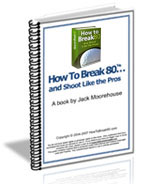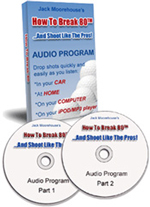|
===================================================
How To Break 80 Newsletter
September 20, 2006
"The Web's Most Popular Golf Improvement Newsletter"
===================================================
In this issue we'll discuss...
1)
Avoiding the Pop-Up
2)
One-Hand Control in Putting
3) Question of the Week
-Curing the Shanks
4) Article - Round Savers-5
Things To Do When Things Go Bad
5) Article - The USGA Slope/Handicap Index System Explained
===================================================
1)
Avoiding the Pop-Up
===================================================
The pop-up is one of the most embarrassing tee shots in
the game, along with the little dribbler out in front. The pop-up goes
straight up in the air, barely clearing the tee box and then comes straight
down. Often, it doesn’t even clear the ladies tee. It’s even more
embarrassing when you pop-up on the first tee.Two things cause a pop-up: (1) shifting excessive
weight forward, and (2) approaching the ball from a very steep angle. Most
players who hit pop-ups never shift their weight correctly during the swing.
Meanwhile, the steep descent de-lofts the clubface, causing the club’s
topline to become its leading edge. Together, these swing faults cause the
ball to go straight up in the air.
Here are 5 tips on eliminating pop-ups:
·
Take a wider stance
·
Maintain a higher position at the top
·
Maintain a lower position at the finish
·
Take a full shoulder turn
·
Shift weight to your back foot
Some simple changes in your set-up help eliminate
pop-ups. The key is making sure your set-up encourages a higher and longer
backswing arc, which in turn shallows out your swing plane and reduces the
steepness of your downswing.
First, widen your
stance, creating room for a big backswing arc. If you’re not comfortable
using a wider stance hit balls with it in practice until you are, then take
it to the course. Also concentrate on maintaining a higher position at the
top of your backswing and a lower position at the finish.
These changes will
train your body to take a full shoulder turn and shift your weight to your
back foot on your backswing, and your forward foot on your downswing,
instead of vice versa.
Eliminating pop-ups
may not turn you into the club champion, but it will improve your game and
help save you face at the same time.
===================================================
2)
One-Hand Control in Putting
===================================================
How many times have you hit what you thought was a good putt only to
have it slide right or left? Putting is all about control. You need to
control both the putterhead and the path on which it travels to be a
good putter. Making a putting stroke using just your “control” hand may
increase your ability to sink putts.
How do you determine which hand is your control hand? Here’s a test I
use with players who take my golf lessons and have trouble keeping their
putts on line.
Place a ball at a distance between three and six
feet from the hole. Try sinking the putt using just your right hand on
the handle of the putter. After attempting 10 putts with the right hand,
try your left. Take note of which hand feels more comfortable when
putting. Often, it’s the one you sink the most putts with, which should
be no surprise.
Few golfers feel the non-dominant hand controlling
the ball. That’s usually the left hand for right-handers. Whatever the
case, work on getting two hands controlling the putterhead in unison.
That means you may have to let your non-dominant hand have a little more
control of the club. If one hand is too dominant, however, it may not
make sense to work on the other hand at all.
In addition, try gripping the club with your
control hand first, followed by the non-dominant hand with a lighter
grip. By using one hand as a control hand and the other as a support,
you may find putting less challenging.
Phone Book Drill
Below is a drill designed to help you learn to
control the path of the putterhead. It’s one you can do in the comfort
of your home.
Drop two phone books on
the floor. Position them far enough apart so that your putterhead barely
squeezes through them. Place a golf ball between the books, assume your
putting posture, and make your stroke. Use the books as a visual guide
to match the lengths of your backstroke and forwardstroke. Matching
lengths ensures a smooth stroke with perfect tempo. You’ll find it
difficult guiding your putter between the books unless your stroke
follows the intended putting line. If your putter strikes either book,
your stroke strayed off-line.
==================================================
3) Question of the Week
==================================================
From Michael Day
Curing the Shanks
Q. How do I cure the
shanks?
A. Thanks for the
question, Michael. A shank occurs
when a ball is caught between the clubface and the hosel, spinning the
ball sideways almost at right angles. A shank results from either a
severe in-to-out swing path, with a closed clubface, or an equally
exaggerated out-to-in swing path.
The main problem with the shanks is that at impact
the player’s hands—and therefore the clubhead— are farther away from his
or her body than at address. The cause: either standing too close to the
ball, preventing the hands from swinging freely past the body, or
shifting one’s weight forward on one’s toes, forcing the hands and
clubface too far from the body. Maintaining too tight a grip can also
contribute to the shanks.
If weight shift is the problem, curling your toes
inside your golf shoes and maintaining them throughout the swing should
cure it. If it doesn’t, place a golf ball under the front of each foot,
pushing your weight back on your heels. Then hit some balls. If gripping
the club too tightly is a problem, lighten up on the grip before
swinging the club, allowing the club to swing freely past your body. You
can also try waggling the club. The whole point of these remedies is
that fundamentally you need to make sure that you are delivering the
clubface to the ball just slightly closer to your body than you normally
would. Imagine on your downswing that you are barely brushing your
right hand against your right thigh instead of “reaching for or casting
at the ball wit your hands. Let them fall naturally.
If you've got a golf question you'd like answered, send an
email to us at
questions@howtobreak80.com and we'll review it. I can't
guarantee that we'll use it but if we do, we'll make sure to
include your name and where you're from.
================================================
If you want to truly discover the secrets of shooting
like the Pros
and creating a more reliable and consistent swing,
check out:
http://www.HowToBreak80.com
Also, for past issues of this newsletter
and some of my most
P.S. Feel free to share this newsletter with
family and friends. If you would like to subscribe to this
newsletter, send a blank email
to
break80ezine@aweber.com
================================================
About the Author
================================================
Jack Moorehouse is the author of the best-selling book
"How To Break
80 and Shoot Like the Pros!". He is NOT a golf
pro, rather a working man that has helped thousands of golfers
from all seven continents lower their handicaps quickly. His
award-winning free weekly newsletter goes out to thousands of
golfers worldwide and provides the latest golf tips, strategies,
techniques and instruction on how to improve your golf game.
|
Tools To
Help Your Game!

eBook

Physical Book

Audio Program

Short Game DVD

Driver DVD
|